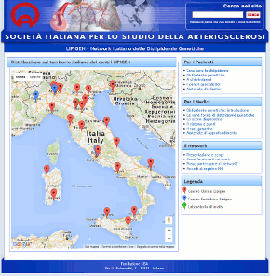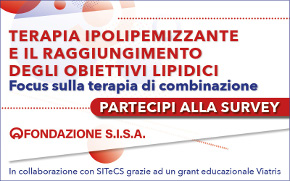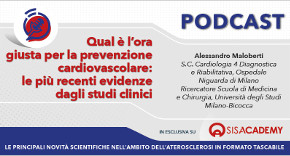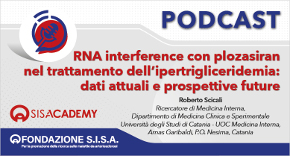 Rivista in lingua italiana
Rivista in lingua italiana
riservata ai Soci SISA
Ultimo numero:
Anno 16 • N.1/2025
SISANews
Evacetrapib aumenta il colesterolo HDL e riduce quello LDL
Il torcetrapib, primo inibitore della proteina di trasporto lipidico (CETP), aveva dimostrato un eccellente effetto sulle HDL ma, quando testato in clinica, non aveva dato buoni risultati ed il suo sviluppo è stato pertanto sospeso. Ma l'interesse per gli inibitori del CETP non è scemato ed attualmente sono in fase avanzata di sperimentazione tre nuove molecole capaci di aumentare in misura considerevole il livello plasmatico del colesterolo HDL, nella speranza che questo possa aggiungere qualcosa alla protezione nei confronti delle malattie cardiovascolari. Tra le nuove molecole vi è l'evacetrapib che da solo o associato alle statine dimostra una buona attività sul colesterolo HDL, che aumenta dal 54% al 130% a seconda della dose, cui si associa una diminuzione del colesterolo LDL (11%-14%) senza effetti collaterali di rilievo. Rimane da dimostrare se l'azione sul quadro lipidico si associ o no ad un effetto positivo sugli eventi cardiovascolari.
![]()
Effects of the CETP inhibitor evacetrapib administered as monotherapy or in combination with statins on HDL and LDL cholesterol: a randomized controlled trial
Nicholls SJ, Brewer HB, Kastelein JJ, Krueger KA, Wang MD, Shao M, Hu B, McErlean E, Nissen SE.
JAMA 2011;306:2099-2109
CONTEXT: Interest remains high in cholesteryl ester transfer protein (CETP) inhibitors as cardioprotective agents. Few studies have documented the efficacy and safety of CETP inhibitors in combination with commonly used statins.
OBJECTIVE: To examine the biochemical effects, safety, and tolerability of evacetrapib, as monotherapy and in combination with statins, in patients with dyslipidemia.
DESIGN, SETTING, AND PARTICIPANTS: Randomized controlled trial conducted among 398 patients with elevated low-density lipoprotein cholesterol (LDL-C) or low high-density lipoprotein cholesterol (HDL-C) levels from April 2010 to January 2011 at community and academic centers in the United States and Europe.
INTERVENTIONS: Following dietary lead-in, patients were randomly assigned to receive placebo (n = 38); evacetrapib monotherapy, 30 mg/d (n = 40), 100 mg/d (n = 39), or 500 mg/d (n = 42); or statin therapy (n = 239) (simvastatin, 40 mg/d; atorvastatin, 20 mg/d; or rosuvastatin, 10 mg/d) with or without evacetrapib, 100 mg/d, for 12 weeks.
MAIN OUTCOME MEASURES: The co-primary end points were percentage changes from baseline in HDL-C and LDL-C after 12 weeks of treatment.
RESULTS: The mean baseline HDL-C level was 55.1 (SD, 15.3) mg/dL and the mean baseline LDL-C level was 144.3 (SD, 26.6) mg/dL. As monotherapy, evacetrapib produced dose-dependent increases in HDL-C of 30.0 to 66.0 mg/dL (53.6% to 128.8%) compared with a decrease with placebo of -0.7 mg/dL (-3.0%; P < .001 for all compared with placebo) and decreases in LDL-C of -20.5 to -51.4 mg/dL (-13.6% to -35.9%) compared with an increase with placebo of 7.2 mg/dL (3.9%; P < .001 for all compared with placebo). In combination with statin therapy, evacetrapib, 100 mg/d, produced increases in HDL-C of 42.1 to 50.5 mg/dL (78.5% to 88.5%; P < .001 for all compared with statin monotherapy) and decreases in LDL-C of -67.1 to -75.8 mg/dL (-11.2% to -13.9%; P < .001 for all compared with statin monotherapy). Compared with evacetrapib monotherapy, the combination of statins and evacetrapib resulted in greater reductions in LDL-C (P <.001) but no greater increase in HDL-C (P =.39). Although the study was underpowered, no adverse effects were observed.
CONCLUSIONS: Compared with placebo or statin monotherapy, evacetrapib as monotherapy or in combination with statins increased HDL-C levels and decreased LDL-C levels. The effects on cardiovascular outcomes require further investigation.

Area Soci
Eventi
39° Congresso Nazionale
 39° Congresso Nazionale
39° Congresso NazionaleRoma, 23-25 novembre 2025
Save the date




 Spring Meeting Gruppi Giovani SID, SIGG, SIIA, SIMI, SIPREC, SISA
Spring Meeting Gruppi Giovani SID, SIGG, SIIA, SIMI, SIPREC, SISARimini, 6-8 aprile 2025
[continua a leggere]
 SISA LIPID ACADEMY - Corso avanzato di lipidologia clinica
SISA LIPID ACADEMY - Corso avanzato di lipidologia clinicaModena, 4-5 Luglio 2024
[continua a leggere]Giornale Italiano Arteriosclerosi
HoFH today
 Rivista Italiana della
Rivista Italiana della
Ipercolesterolemia
Familiare Omozigote
Anno 6 • N.1/2024
Rivista NMCD
Diateca
[continua a leggere]
[continua a leggere]
Newsletter
il vostro indirizzo di posta elettronica
Progetto LIPIGEN

Nuovo sito dedicato al Progetto LIPIGEN
Progetto LIPIGEN - Vecchio portale
E' necessario essere loggati come utente
Lipigen per poter accedere alla pagina
PROject Statin Intolerance SISA
PROSISA – PROject Statin Intolerance SISA
E' necessario essere loggati come utente
PROSISA per poter accedere alla pagina
GILA - Lipoprotein Aferesi
Gruppo Interdisciplinare Lipoprotein Aferesi
(Accesso Gruppo GILA-Lipoprotein Aferesi)
E' necessario essere loggati come utente del Gruppo GILA per poter accedere
Gruppo Interdisciplinare Lipoprotein Aferesi
(Documentazione ad accesso libero)
Pagina informativa per medici e pazienti










